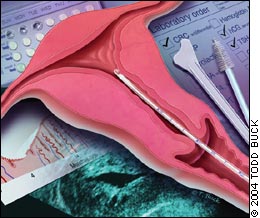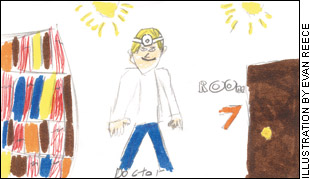
Am Fam Physician. 2004;69(8):1841

April is career month for many students, and later this month local students will be visiting the American Academy of Family Physicians for Take Your Children to Work Day. We're hoping our children will learn more about family medicine and possibly even consider a career in medicine for themselves. The picture below shows an eight-year-old boy's perspective of a doctor—a smiling friend who is capable of handling mounds of medical files and whatever lurks behind the door of room 7. My guess is the great height of the physician and the bright cast of light about him show how much the child respects the physician as an authority. I believe the child (who happens to be my son) was inspired for this second-grade career-day assignment by a recent visit to the doctor, who commented that he never knew what he'd find behind the examining room door.
That's surely the sentiment of many family physicians on entering their examining rooms. What type of problem might you diagnose in room 7 today? Now that the flu season is over, you will probably start seeing the usual signs of spring—not just the early crocuses, greening grass, and budding trees, but also pollen allergies, injuries, and illnesses related to increased outdoor activities. Although we can't predict everything you will find behind your examining room door, this issue of AFP offers several articles that might help with some of your patients this vernal season.

In a two-part article on injuries of the hand and wrist, James M. Daniels II, M.D., M.P.H., and colleagues review the nonemergent and emergent evaluation and treatment of a variety of injuries (see pages 1941 and 1949). Patients may show up in the clinic with fractures of the wrist, ligamentous instability involving the scaphoid and lunate, or finger trauma such as mallet finger, jersey finger, boutonniere finger, or coach's finger. For patients with severe hand or wrist injuries, such as amputations or vessel lacerations, the physician must be prepared to provide evaluation, triage, and stabilization before obtaining surgical consultation. Infectious complications include fight bite, open fracture, purulent tenosynovitis, animal bites, and retained foreign bodies.
For your patients who frequent the woods, tick-borne disease should be a consideration. In a photo essay on page 1935, Vincent Lo Re III, M.D., and colleagues review the diagnosis and treatment of Lyme disease, which is caused by the spirochete Borrelia burgdorferi, carried by the deer tick.